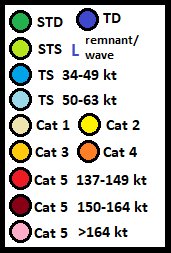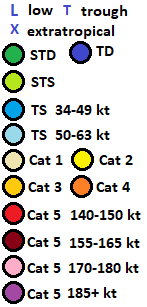Verification of tracks made of Karen using GEFS mean fields
I made two tracks of Tropical Storm Karen. Additionally, within
384
hours of cyclogenesis, there were eight instances, when I missed
cyclogenesis entirely. The two tracks were at short lead times, peak intensity was way too high, too much longevity, and position errors were often also high.
As of this analysis, best track positions are available September 19, 18Z thru September 27, 18Z, and as such, position comparisons are possible only for this timespan.
Since I give only SSHS categories in my tracks, I don't calculate intensity errors in units of speed, but in categories. For this purpose, I define tropical or subtropical storms as "Category 0", tropical or subtropical depressions as "Category -1" and non-existence of a tropical or subtropical cyclone as "Category -2".
In the two tracks, formation times ranged between September 22, 12Z and September 24, 06Z. Average and median was September 23, 09Z.
In the ten cases (2 tracks and 8 complete misses), peak intensity ranged between Category -2 and Category 5. Average was Category -0.60 and median was Category -2.
In the two tracks, dissipation times ranged between October 6, 00Z and October 7, 06Z. Average and median was October 6, 15Z.
At the lead time of 1 day (24 hours), there were 0 hits, 0 false detections and 0 misses. No available position comparisons.
At the lead time of 2 days (48 hours), there were 0 hits, 0 false detections and 0 misses. No available position comparisons.
At the lead time of 3 days (72 hours), there were 0 hits, 0 false detections and 1 miss. No available position comparisons.
At the lead time of 4 days (96 hours), there were 1 hit, 0 false detections and 0 misses. 1 available position comparison produces an average error of 154 nautical miles.
At the lead time of 5 days (120 hours), there were 1 hit, 0 false detections and 1 miss. 1 available position comparison produces an average error of 131 nautical miles.
At the lead time of 6 days (144 hours), there were 1 hit, 0 false detections and 2 misses. 1 available position comparison produces an average error of 275 nautical miles.
At the lead time of 7 days (168 hours), there were 2 hits, 0 false detections and 1 miss. 2 available position comparisons produce an average error of 394 nautical miles.
At the lead time of 8 days (192 hours), there were 2 hits, 0 false detections and 2 misses. 2 available position comparisons produce an average error of 682 nautical miles.
At the lead time of 9 days (216 hours), there were 1 hit, 1 false detection and 3 misses. 1 available position comparison produces an average error of 640 nautical miles.
At the lead time of 10 days (240 hours), there were 0 hits, 2 false detections and 3 misses. No available position comparisons.
At the lead time of 11 days (264 hours), there were 0 hits, 2 false detections and 4 misses. No available position comparisons.
At the lead time of 12 days (288 hours), there were 0 hits, 2 false detections and 4 misses. No available position comparisons.
At the lead time of 13 days (312 hours), there were 0 hits, 2 false detections and 4 misses. No available position comparisons.
At the lead time of 14 days (336 hours), there were 0 hits, 2 false detections and 4 misses. No available position comparisons.
At the lead time of 15 days (360 hours), there were 0 hits, 2 false detections and 4 misses. No available position comparisons.
At the lead time of 16 days (384 hours), there were 0 hits, 2 false detections and 4 misses. No available position comparisons.
Circle coloration scheme
Here are the tracks once again.
September 18, 00Z run:
September 19, 06Z run:
The complete misses were from the following runs:
September 6, 06Z
September 7, 06Z
September 8, 06Z
September 10, 06Z
September 11, 06Z
September 13, 06Z
September 14, 06Z
September 16, 06Z
As of this analysis, best track positions are available September 19, 18Z thru September 27, 18Z, and as such, position comparisons are possible only for this timespan.
Since I give only SSHS categories in my tracks, I don't calculate intensity errors in units of speed, but in categories. For this purpose, I define tropical or subtropical storms as "Category 0", tropical or subtropical depressions as "Category -1" and non-existence of a tropical or subtropical cyclone as "Category -2".
In the two tracks, formation times ranged between September 22, 12Z and September 24, 06Z. Average and median was September 23, 09Z.
In the ten cases (2 tracks and 8 complete misses), peak intensity ranged between Category -2 and Category 5. Average was Category -0.60 and median was Category -2.
In the two tracks, dissipation times ranged between October 6, 00Z and October 7, 06Z. Average and median was October 6, 15Z.
At the lead time of 1 day (24 hours), there were 0 hits, 0 false detections and 0 misses. No available position comparisons.
At the lead time of 2 days (48 hours), there were 0 hits, 0 false detections and 0 misses. No available position comparisons.
At the lead time of 3 days (72 hours), there were 0 hits, 0 false detections and 1 miss. No available position comparisons.
At the lead time of 4 days (96 hours), there were 1 hit, 0 false detections and 0 misses. 1 available position comparison produces an average error of 154 nautical miles.
At the lead time of 5 days (120 hours), there were 1 hit, 0 false detections and 1 miss. 1 available position comparison produces an average error of 131 nautical miles.
At the lead time of 6 days (144 hours), there were 1 hit, 0 false detections and 2 misses. 1 available position comparison produces an average error of 275 nautical miles.
At the lead time of 7 days (168 hours), there were 2 hits, 0 false detections and 1 miss. 2 available position comparisons produce an average error of 394 nautical miles.
At the lead time of 8 days (192 hours), there were 2 hits, 0 false detections and 2 misses. 2 available position comparisons produce an average error of 682 nautical miles.
At the lead time of 9 days (216 hours), there were 1 hit, 1 false detection and 3 misses. 1 available position comparison produces an average error of 640 nautical miles.
At the lead time of 10 days (240 hours), there were 0 hits, 2 false detections and 3 misses. No available position comparisons.
At the lead time of 11 days (264 hours), there were 0 hits, 2 false detections and 4 misses. No available position comparisons.
At the lead time of 12 days (288 hours), there were 0 hits, 2 false detections and 4 misses. No available position comparisons.
At the lead time of 13 days (312 hours), there were 0 hits, 2 false detections and 4 misses. No available position comparisons.
At the lead time of 14 days (336 hours), there were 0 hits, 2 false detections and 4 misses. No available position comparisons.
At the lead time of 15 days (360 hours), there were 0 hits, 2 false detections and 4 misses. No available position comparisons.
At the lead time of 16 days (384 hours), there were 0 hits, 2 false detections and 4 misses. No available position comparisons.
Circle coloration scheme
Here are the tracks once again.
September 18, 00Z run:
September 19, 06Z run:
The complete misses were from the following runs:
September 6, 06Z
September 7, 06Z
September 8, 06Z
September 10, 06Z
September 11, 06Z
September 13, 06Z
September 14, 06Z
September 16, 06Z




Comments
Post a Comment